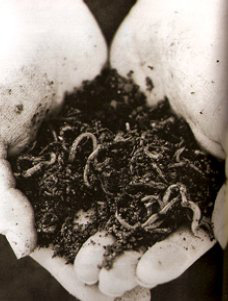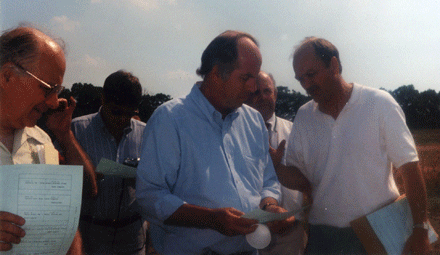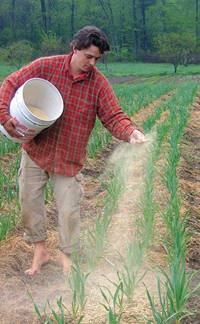Amendment Providers
Global Repair www.globalrepair.ca/fertilizer.htm
Tainio Technology and Technique, inc. www.tainio.com
International Ag Labs, inc. www.aglabs.com
Midwestern Bio-Ag www.midwesternbioag.com
Rocks for Crops
Rocks for Crops
From humble beginnings in Tanzania in 1984 to the establishment of a course at the University of Guelph, to the official opening of an Agrogeology Centre in Indonesia, the field of agrogeology is gaining wider global interest and exposure. The first Rocks for Crops International Conference took place in Brasilia, Brazil on November 7-14, 2004. Visit their website, Rocks for Crops , for abstracts of papers from the conference. Remineralize the Earth is working on the development of a large research database that will include agrogeology research from all ...
The Eco-Logic of Vermiculture
Each organism has a role and occupies a niche. In fact, shown by the Russian ecologist, Gause, about 30 years ago that each niche has only one organism with its specific food. If another organism is introduced, it either gets wiped out or creates its own micro-niche by living symbiotically with the first, for example, by using the waste matter of the first organism as food.
(more…)
1994 USDA Symposium on Remineralization
Soil Remineralization An Essential Environmental Action
On May 24, 1994, the U.S. Department of Agriculture (USDA) (Beltsville, MD), the U.S. Bureau of Mines (USBM) (Washington, DC), the National Stone Association (NSA) Washington, DC), and the National Aggregates Association (NAA) (Silver Springs, MD) cosponsored a forum on "Soil Remineralization and Sustainable Agriculture" at the USDA Agricultural Research Station in Beltsville, MD. That forum could represent a milestone marking officially-sanctioned efforts to implement long overdue action of fundamental importance to ...
Minerals for Aging Soils
By Dr. Lee Klinger, Ph.D.
Now that I've passed the half-century mark I feel fortunate to be only slightly worse for the wear as my body copes with getting older.
Nonetheless, lingering aches in my joints and bones are telling signs that my body is aging. These aches come as no surprise of course. Scientific studies indicate that as organisms grow old their metabolisms slow down and their tissues acidify. Acidification leads to a departure from the chemically balanced, neutral pH state preferred by most living systems, around pH 7. I'm quite aware that the buildup of ...
How to Remineralize the Earth: Getting vital nutrients back into our soil
We know that "traditionally grown" fruits and vegetables we see in supermarkets are both lacking in vitamins and minerals and have added chemicals from fertilizers and pesticides. These toxic additions in particular fueled the demand for organic produce but did not completely address the lack of nutrients.
Going back in time, our soil was rich with minerals, which found their way into our foods in healthy doses. Mineralized soil grew healthier crops providing the vitamins and minerals we now need to take as supplements. Additionally, hardier plants were capable of ...
Remineralize the Earth Embarks on a Research Project at the University of Massachusetts Amherst
Remineralize the Earth Embarks on a Research Project at the University of Massachusetts Amherst
RTE has just embarked on a research project in collaboration with the University of Massachusetts to document the effect on nutrient density of crops with the application of rock dusts and biological amendments. Click here for magazine article .
Soil Remineralization and the Climate
Soil Remineralization
The soils of the entire world have become severely demineralized by erosion over thousands of years. Plants require a continuous intake of minerals, just as we do, and for very similar reasons - calcium to build structural support, iron to carry oxygen, and so on. Plants growing on mineral-depleted soil do not get enough nourishment and so become smaller, less-abundant and less hardy, more vulnerable to the insects, worms and fungi that prey upon them.
Remineralization has been shown to cause a phenomenal growth of the microorganisms in the soil. It ...
Soil Remineralization in Context
One of many anecdotal photos sent over the years to the magazine in the early remineralization movement in the 1980s. These two oak leaves were sent by Jeannie Stevens from Victoria Australia. The larger leaf was that of an oak tree that was remineralized in March 1984. At that time the leaf was the same size as the smaller one on the left. There was a magnificent forest of seedlings under that tree in December 1986. The oak tree nearby with the smaller leaf on the left was not given an application of rock dust and had very few viable acorns and weak seedlings.
Soil ...
Why Remineralize?
In this unintended "experiment" in our garden, we remineralized soil in one raised bed with finely ground granite residue from a water well drilling site. The remineralized soil produced the carrots on the left. Carrots planted earlier, in soil not yet remineralized, but otherwise more improved, are shown at the right for comparison. Dust obtained from a mixture of rock types would have even more dramatic results, according to Weaver and Hamaker. These results were typical for all crops receiving rock dust in our 1985 garden.
--Dan Hemenway
Benefits of Remineralization
...











